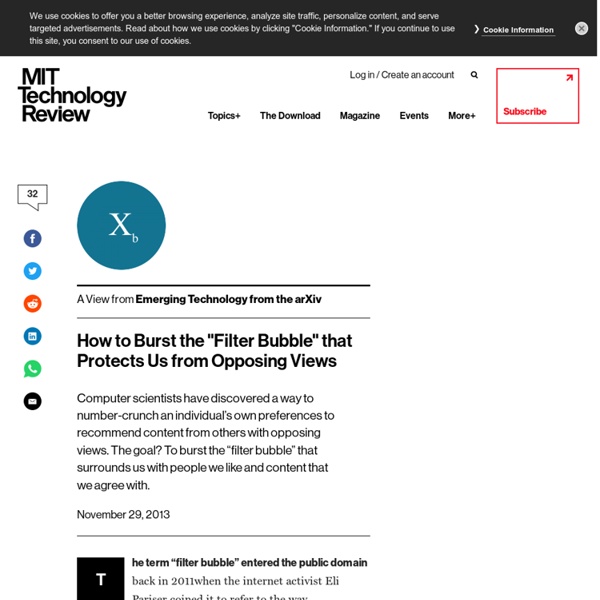US Military Scientists Solve the Fundamental Problem of Viral Marketing
Viral messages begin life by infecting a few individuals and then start to spread across a network. The most infectious end up contaminating more or less everybody. Just how and why this happens is the subject of much study and debate. Network scientists know that key factors are the rate at which people become infected, the “connectedness” of the network and how the seed group of individuals, who first become infected, are linked to the rest. It is this seed group that fascinates everybody from marketers wanting to sell Viagra to epidemiologists wanting to study the spread of HIV.
Filter bubble
Intellectual isolation involving search engines The term filter bubble was coined by internet activist Eli Pariser, circa 2010. A filter bubble or ideological frame is a state of intellectual isolation[1] that can result from personalized searches when a website algorithm selectively guesses what information a user would like to see based on information about the user, such as location, past click-behavior and search history.[2][3][4] As a result, users become separated from information that disagrees with their viewpoints, effectively isolating them in their own cultural or ideological bubbles.[5] The choices made by these algorithms are not transparent.[6] Prime examples include Google Personalized Search results and Facebook's personalized news-stream. (Technology such as social media) “lets you go off with like-minded people, so you're not mixing and sharing and understanding other points of view ...
Small world experiment
The "six degrees of separation" model The small-world experiment comprised several experiments conducted by Stanley Milgram and other researchers examining the average path length for social networks of people in the United States. The research was groundbreaking in that it suggested that human society is a small-world-type network characterized by short path-lengths. The experiments are often associated with the phrase "six degrees of separation", although Milgram did not use this term himself. Historical context of the small-world problem[edit] Mathematician Manfred Kochen and political scientist Ithiel de Sola Pool wrote a mathematical manuscript, "Contacts and Influences", while working at the University of Paris in the early 1950s, during a time when Milgram visited and collaborated in their research.
The Global Brain Institute
The GBI uses scientific methods to better understand the global evolution towards ever-stronger connectivity between people, software and machines. By developing concrete models of this development, we can anticipate both its promises and its perils. That would help us to steer a course towards the best possible outcome for humanity.
Escape your search engine Filter Bubble!
DuckDuckGo does not collect or share personal information. That is our privacy policy in a nutshell. The rest of this page tries to explain why you should care. Last updated on 04/11/12.
Network science
{{Scienc[1] e}} Network science is an interdisciplinary academic field which studies complex networks such as telecommunication networks, computer networks, biological networks, cognitive and semantic networks, and social networks. The field draws on theories and methods including graph theory from mathematics, statistical mechanics from physics, data mining and information visualization from computer science, inferential modeling from statistics, and social structure from sociology. The United States National Research Council defines network science as "the study of network representations of physical, biological, and social phenomena leading to predictive models of these phenomena."[2]
New research to uncover nuances of networks
Feb. 20, 2013 9:01 a.m. When a species disappears from a region, the rest of the ecosystem may flourish or collapse, depending on the role that species played. When a storm rolls across the coast, the power grid might reconfigure itself quickly or leave cities dark for days. A snowstorm might mean business as usual in a hardy city and a severe food shortage in another, depending on the distribution strategies of residents. Each of these systems is a kind of network, with thousands of members and relationships linking them. Understanding how networks behave is key to ensuring their functioning.
Connectionism
Connectionism is a set of approaches in the fields of artificial intelligence, cognitive psychology, cognitive science, neuroscience, and philosophy of mind, that models mental or behavioral phenomena as the emergent processes of interconnected networks of simple units. There are many forms of connectionism, but the most common forms use neural network models. Basic principles[edit]
Self-organizing map
A self-organizing map (SOM) or self-organizing feature map (SOFM) is a type of artificial neural network (ANN) that is trained using unsupervised learning to produce a low-dimensional (typically two-dimensional), discretized representation of the input space of the training samples, called a map. Self-organizing maps are different from other artificial neural networks in the sense that they use a neighborhood function to preserve the topological properties of the input space. This makes SOMs useful for visualizing low-dimensional views of high-dimensional data, akin to multidimensional scaling.
Math algorithm tracks crime, rumours, epidemics to source
(Phys.org) -- A team of EPFL scientists has developed an algorithm that can identify the source of an epidemic or information circulating within a network, a method that could also be used to help with criminal investigations. Investigators are well aware of how difficult it is to trace an unlawful act to its source. The job was arguably easier with old, Mafia-style criminal organizations, as their hierarchical structures more or less resembled predictable family trees.



